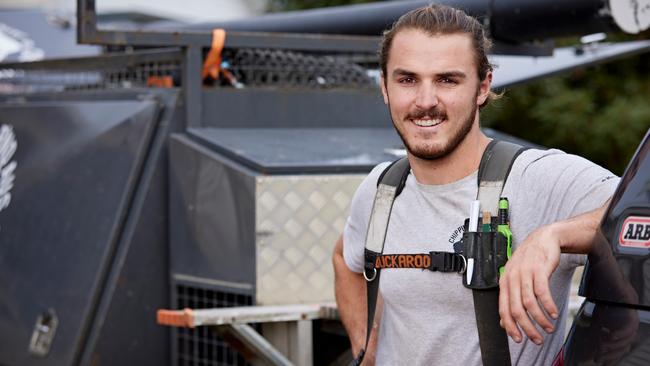Financial barriers increasingly preventing Aussies from becoming tradies
Only the rich will soon be able to afford to learn a trade as high training fees and low wages collide, experts warn. See their advice for apprentices struggling to make ends meet.
Careers
Don't miss out on the headlines from Careers. Followed categories will be added to My News.
Apprentices are forking out thousands of dollars a year for training, prompting fears that only the rich can now afford to learn a trade.
Experts warn training courses and associated learning fees, along with low apprentice wages, are deterring many young Aussies from becoming tradies, exacerbating a decades-long skills shortage that is crippling the nation.
While employers typically meet apprentice training costs, many apprentices are forced to pay course fees upfront and then seek reimbursement. They sometimes wait up to six months for their money to be returned.
In some instances, such as if their training progress is deemed unsatisfactory, apprentices may not be reimbursed at all.
With training costing up to $16,000 a year, many apprentices are struggling to survive, says Gary Workman, executive director of the Apprentice Employment Network of Victoria.
“It can be really tough,” Workman says. “(Having to pay training costs) is challenging for a fairly large proportion of people that go into apprenticeships.
“If you’re trying to pay for rent and food and for a car to get to work and other things as well, on a really low wage, I think it would be nearly impossible.”

Fee-free TAFE
Ahead of the federal budget, the government announced a $62.4m investment in 15,000 fee-free TAFE courses for apprentices in the building sector, in a bid to bolster the construction workforce and address Australia’s severe housing shortage.
The funding, over two years, will cover a range of skills relevant to residential construction, from electricians and builders to surveyors and drafts people.
A further $26.4m will be available for school students who complete pre-apprenticeship programs.
The Australian Industry Group and Master Builders Australia welcomed the announcement. But others, including not-for-profit jobs provider Workskil Australia, say it will not help apprentices and trainees in other sectors, many of whom will still foot the bill for their training, at least initially.
To date, Workman says fee-free TAFE programs have typically applied only to students who enrol outside of a formal apprenticeship or traineeship.
But as they have no on-the-job component, those students have significantly reduced course completion rates and employment outcomes, says Workman, who wants all apprenticeships and traineeships to be funded in the same manner as fee-free TAFE.

‘Scrounging for a feed’
Recently qualified carpenter Jayme Cannon says he would have struggled to find the $1500 he needed for each stage of his four-year apprenticeship if it wasn’t for the support of his parents.
Cannon was out-of-pocket for months before his first training fees were reimbursed. But, after changing employers in his second year, reimbursement time was reduced to weeks.
“It (finding the money) was definitely a problem. I had to scrounge around for a feed here and there,” says Cannon, who since finishing his apprenticeship has started his own business, Chipping Around.
“It gets as low as eating cans of tuna and rice crackers and not having a proper meal – not all the time, just every now and then depending on what other bills I had coming in.”

On top of the immediate training costs, Cannon spent hundreds of dollars on textbooks and tools.
He cannot understand why apprentice training fees are charged upfront when university students have the option of financing their tuition through Higher Education Loan Program accounts, commonly known as HECS.
“Everyone wants more tradies. but it costs money to become one,” Cannon says.
“There’s plenty of uni courses that are free (do not require upfront payment) but not any trades (qualifications) that are free – and it’s turning people away from doing them.”
High cost of trades
The lifelong earnings of qualified tradies now easily eclipse that of university graduates. But the cost of training, combined with the initially low rates of pay, are discouraging more Aussies from picking up the tools, says Workskil Australia chief executive officer Nicole Dwyer.
She says apprenticeships are increasingly accessible only by “people from high-socio-economic areas”, who can afford not only the upfront training fees but also text books, a computer, tools, work clothes and PPE, plus a vehicle if the apprentice is required to transport heavy tools across various work sites.
“We’re talking thousands of dollars (in additional costs for apprentices),” Dwyer says.
“But it’s very hard to afford all this for 17 bucks an hour (pay) for a four-year period.”
Workskil Australia is trying to fill 200 apprenticeship vacancies, primarily in building and construction, hairdressing and cooking. But Dwyer says interest is lacking and higher wages are needed to turn the situation around.
“We have (jobseekers) who love doing practical, outdoor work but there’s trepidation around (apprenticeships because of) those added costs. It’s making (trades careers) very unattractive,” she says.
Making ends meet
Tips for apprentices struggling to pay training fees and living costs:
1. Ask your employer if they can offer financial assistance, such as paying training fees upfront or providing additional support with tools and travel.
2. Research available funding for apprenticeships in your area. There may be government grants, scholarships or bursaries to help cover living costs or training fees.
3. Seek advice from a financial adviser or counsellor who can help you manage your finances.
4. Contact your training provider to discuss options for delayed payment of training fees or setting up a payment plan that fits your budget.
5. Check if your apprenticeship program offers support services for students facing financial difficulties.
6. Take advantage of discounts offered to students and apprentices for travel, groceries and utilities. For example, Victoria offers free vehicle registration for apprentices.
Source: Gary Workman, Apprentice Employment Network of Victoria


